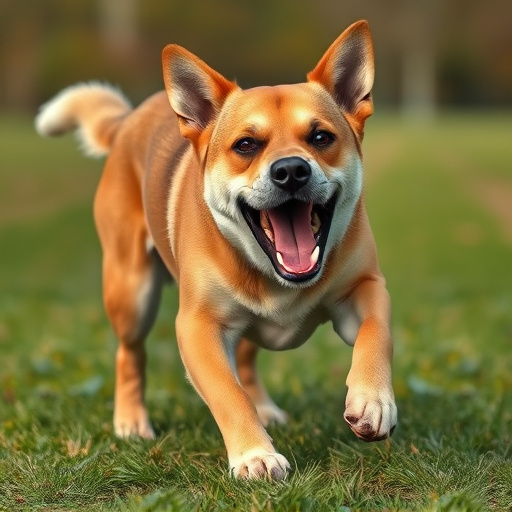Dog attacks can be prevented through understanding breed dynamics, training, and socialization. When facing an attack, pepper spray with 10-20% capsaicin is recommended. Mace usage is regulated, so check local laws. The best mace for dog defense has a sturdy design, high-impact formula (like metal core), and optimal concentrations (12% carbon steel or higher). Target sensitive areas like face and eyes first, aiming for nose and eyes specifically. Mace should be a last resort after de-escalation attempts, used responsibly, and in accordance with local laws to maximize effectiveness.
In many regions, dog attacks are a growing concern, leading to serious injuries and even fatalities. Understanding the dynamics of these incidents is crucial for effective prevention strategies. This article delves into the world of dog defense tools, focusing on mace as a potential solution. We explore legal considerations, key features, optimal concentrations (like the best mace concentration for dog defense), deployment techniques, and safety tips to empower individuals in navigating such emergencies.
- Understanding Dog Attack Dynamics: Factors and Prevention
- The Role of Mace in Dog Defense: Legal Considerations
- Choosing the Right Mace: Key Features and Concentrations
- Effective Use Cases: When and How to Deploy Dog Defense Mace
- Training and Safety Tips: Maximizing Mace Efficacy for Dog Attacks
Understanding Dog Attack Dynamics: Factors and Prevention
Dog attacks can be unpredictable, but understanding certain dynamics helps in prevention and effective response. Several factors contribute to a dog’s aggressive behavior, including breed characteristics, training, socialization, territory protection, fear, or pain. Recognizing these triggers is crucial for avoiding potential hazards. Regularly scheduled walks, proper training, and early socialization are key preventive measures that responsible pet owners should implement.
When dealing with an imminent dog attack, knowing the best mace concentration is vital. Pepper spray designed for animal defense typically contains a higher concentration of capsaicin than regular pepper spray, making it more effective against dogs. The recommended concentration for animal defense mace is around 10% to 20%, ensuring a strong enough irritant to deter aggressive behavior without causing severe harm.
The Role of Mace in Dog Defense: Legal Considerations
When it comes to protecting yourself from dog attacks, mace can be a powerful tool. However, its use is heavily regulated and varies by jurisdiction. In many areas, mace is classified as a weapon, and its application against animals, including dogs, may carry legal repercussions. It’s crucial to understand the specific laws in your region before considering it as a defense mechanism.
The best mace concentration for dog defense should be strong enough to deter an attack but not cause excessive harm or permanent injury. Many experts recommend pepper-based mace, which is less likely to cause serious health issues in dogs and humans alike. Always opt for products designed specifically for animal control and follow the manufacturer’s instructions regarding safe and effective use.
Choosing the Right Mace: Key Features and Concentrations
When selecting a mace for dog attack defense, understanding the key features and best concentrations is paramount. Look for a mace with a sturdy, durable design that can withstand intense impacts without breaking or bending. The handle should be ergonomically designed for comfortable grip and control, allowing you to swing with precision even in stressful situations.
In terms of concentration, the best mace for dog defense typically features a high-impact formula, such as a metal core combined with a robust outer shell. A recommended concentration is around 12% carbon steel or higher, which offers excellent penetrance and force distribution. Additionally, consider a mace with a weight range suitable for your comfort level and the potential threat—typically ranging from 6 to 16 ounces for personal defense against dogs.
Effective Use Cases: When and How to Deploy Dog Defense Mace
When it comes to dog attack defense, mace can be an effective tool when used appropriately. The best mace concentration for dog defense should focus on targeted areas like the face and eyes, as these are sensitive points that can quickly disable or deter an attacker. It’s crucial to use mace in situations where a dog poses an immediate threat, such as when it displays aggressive behavior, charges, or bites.
To deploy dog defense mace effectively, aim for the dog’s nose and eyes first, followed by its sides and hind legs if necessary. Keep in mind that mace should be used as a last resort, only when other de-escalation methods have failed. Additionally, ensure you are familiar with local laws regarding the use of mace to avoid any legal repercussions.
Training and Safety Tips: Maximizing Mace Efficacy for Dog Attacks
When it comes to mace for dog attacks, understanding the best mace concentration and safety practices is crucial. The key lies in maximizing its efficacy while ensuring responsible usage. First, choose a mace designed specifically for animal deterrence, as these often have higher pepper concentrations tailored for powerful kicks and bites. Second, train yourself on proper application techniques—aim for the eyes, nose, and mouth, areas most sensitive to capsaicin, the active ingredient in mace.
Practice in controlled settings to build muscle memory. Wear protective gear during training to avoid accidental irritation or damage. Always store your mace securely, out of reach of children and pets, and familiarize yourself with local laws regarding its use. Regularly inspect and maintain your mace to ensure it remains effective when needed most.
In conclusion, while mace can be a valuable tool for self-defense against dog attacks, understanding its legal implications and effective use is crucial. The best mace concentration for dog defense, as highlighted in this article, should balance potency with safety to minimize harm to both the aggressor and bystander dogs. Proper training and adherence to safety tips are essential to maximize efficacy and prevent further incidents. By arming ourselves with knowledge and the right equipment, we can better navigate and respond to potential dog attack scenarios.
